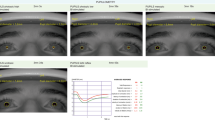Abstract
Introduction and hypothesis
Anticholinergic medication is the mainstay of pharmacotherapy for overactive bladder (OAB). The aim of the study is to investigate the effect of oral solifenacin succinate on intraocular pressure (IOP) in female OAB patients and to discuss the ocular drawbacks during treatment.
Methods
The female patients with a clinical diagnosis of OAB in whom use of oral solifenacin succinate 5 mg/day (group I) and age-matched healthy female subjects (group II) underwent complete ophthalmological examination, including IOP measurement at the beginning of the oral treatment and after 4 weeks. The patients with a history of previous ocular surgery and those with ocular diseases besides refraction disorders and presbyopia were excluded.
Results
The data from the right eyes of 60 consecutive patients in group I and 30 consecutive patients in group II were used for analysis. No statistically significant change was detected in the IOP (from 16.05 ± 2.30 mmHg to 16.30 ± 2.25 mmHg at the 4th week in group I, p = 0.160; from 15.60 ± 2.14 mmHg to 15.60 ± 2.09 mmHg at the 4th week in group II, p = 0.864) of the eyes in both groups.
Conclusions
Since the power of the study is not enough to draw a clear conclusion, a 4-week course of solifenacin succinate treatment in women with OAB seemed to have no clinically significant effect on IOP values. Further larger studies are needed to determine the effect of anticholinergics on anterior chamber parameters and to evaluate their safety in glaucoma patients.
Similar content being viewed by others
References
Abrams P, Cardozo L, Fall M (2003) Standardisation Sub-Committee of the International Continence Society. The standardisation of terminology in lower urinary tract function: report from the standardisation sub-committee of the International Continence Society. Urology 61(1):37–49
Haylen BT, de Ridder D, Freeman RM, Swift SE, Berghmans B et al (2010) An International Urogynecological Association (IUGA)/International Continence Society (ICS) joint report on the terminology for female pelvic floor dysfunction. Int Urogynecol J 21:5–26. doi:10.1007/s00192-009-0976-9
Gormley EA, Lightner DJ, Burgio KL (2012) American Urological Association; Society of Urodynamics, Female Pelvic Medicine & Urogenital Reconstruction. Diagnosis and treatment of overactive bladder (non-neurogenic) in adults: AUA/SUFU guideline. J Urol 188(6 Suppl):2455–2463
Andersson KE (2004) Antimuscarinics for treatment of overactive bladder. Lancet Neurol 3(1):46–53
Tripathi RC, Tripathi BJ, Haggerty C (2003) Drug-induced glaucomas: mechanism and management. Drug Saf 26(11):749–767
Garely AD, Kaufman JM, Sand PK et al (2006) Symptom bother and health-related quality of life outcomes following solifenacin treatment for overactive bladder: the VESIcare Open-Label Trial (VOLT). Clin Ther 28(11):1935–1946
Sung VC, Corridan PG (1998) Acute-angle closure glaucoma as a side-effect of oxybutynin. Br J Urol 81(4):634–635
Ouslander JG, Blaustein J, Connor A et al (1988) Pharmacokinetics and clinical effects of oxybutynin in geriatric patients. J Urol 140(1):47–50
Altan-Yaycioglu R, Yaycioglu O, Aydin Akova Y et al (2005) Ocular side-effects of tolterodine and oxybutynin, a single-blind prospective randomized trial. Br J Clin Pharmacol 59(5):588–592
Frischmeyer KJ, Miller PE, Bellay Y et al (1993) Parenteral anticholinergics in dogs with normal and elevated intraocular pressure. Vet Surg 22(3):230–234
Homma Y, Kakizaki H, Gotoh M et al (2003) Epidemiologic survey on urination. J Jpn Neurogenic Bladder Soc 14:266–277
Iwase A (2003) The prevalence of glaucoma in Japan. Ganka 45:733–739
Kato K, Furuhashi K, Suzuki K et al (2007) Overactive bladder and glaucoma: a survey at outpatient clinics in Japan. Int J Urol 14(7):595–597
Kato K, Yoshida K, Suzuki K et al (2005) Managing patients with an overactive bladder and glaucoma: a questionnaire survey of Japanese urologists on the use of anticholinergics. BJU Int 95(1):98–101
Fink AM, Aylward GW (1995) Buscopan and glaucoma: a survey of current practice. Clin Radiol 50(3):160–164
Financial disclaimer and conflicts of interest
None.
Author information
Authors and Affiliations
Corresponding author
Rights and permissions
About this article
Cite this article
Sekeroglu, M.A., Hekimoglu, E., Petricli, İ.S. et al. The effect of oral solifenacin succinate treatment on intraocular pressure: glaucoma paradox during overactive bladder treatment. Int Urogynecol J 25, 1479–1482 (2014). https://doi.org/10.1007/s00192-014-2396-8
Received:
Accepted:
Published:
Issue Date:
DOI: https://doi.org/10.1007/s00192-014-2396-8



